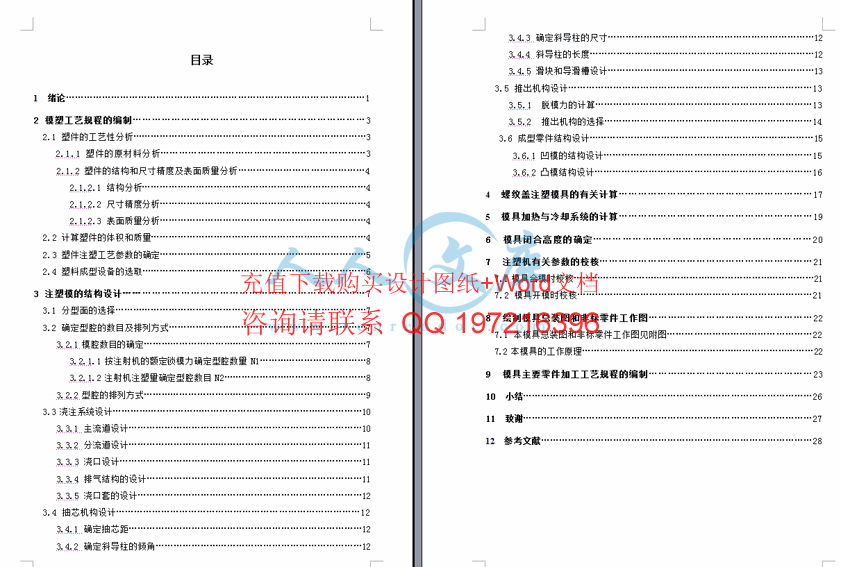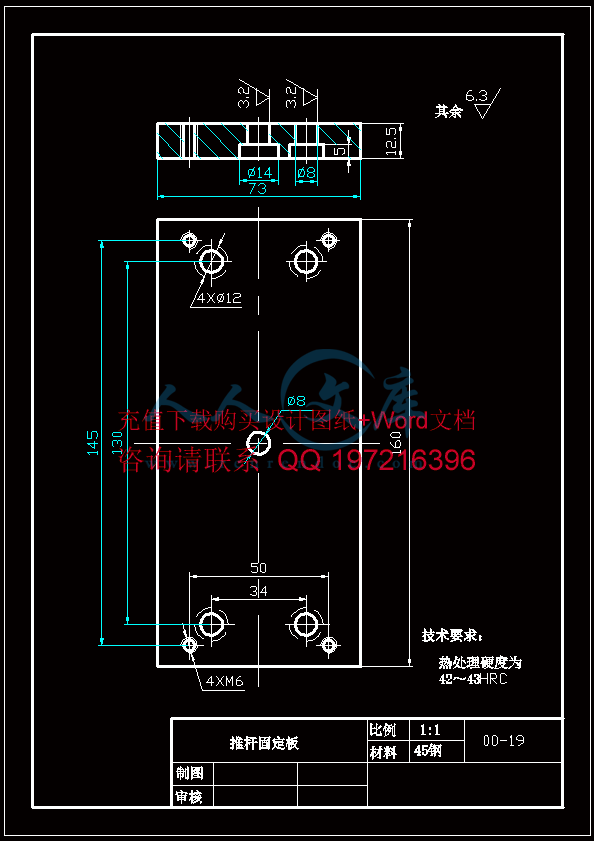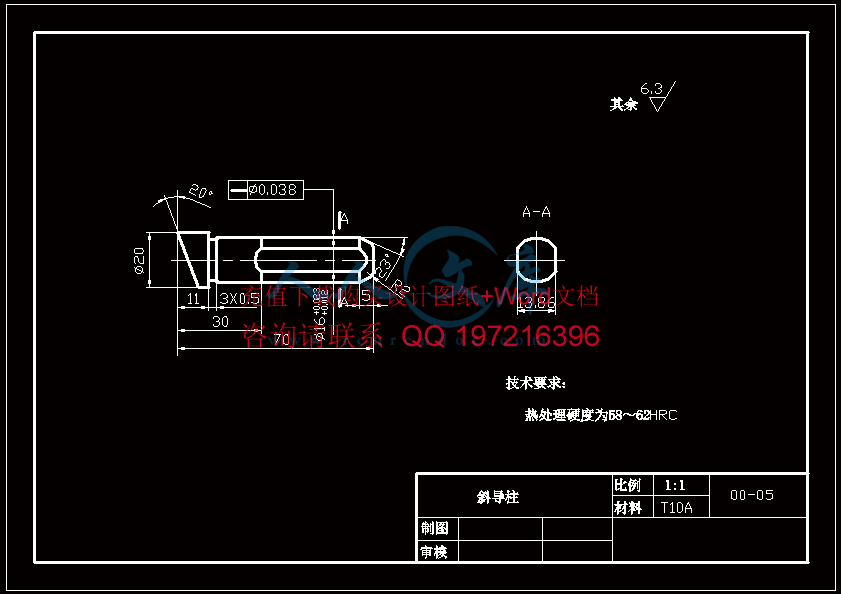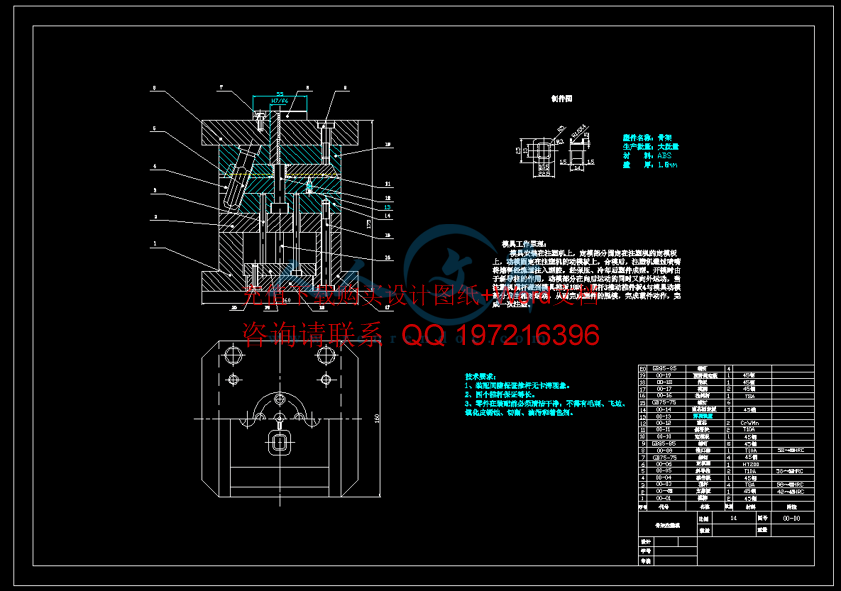骨架塑件成型工艺及模具设计(全套含CAD图纸)
收藏
资源目录

压缩包内文档预览:(预览前20页/共34页)
编号:6035578
类型:共享资源
大小:1.62MB
格式:ZIP
上传时间:2017-10-24
上传人:机****料
认证信息
个人认证
高**(实名认证)
河南
IP属地:河南
50
积分
- 关 键 词:
-
骨架
成型
工艺
模具设计
全套
cad
图纸
- 资源描述:
-













- 内容简介:
-
毕业设计(论文)译文0 一种面向对象的注塑模关联冷却水道设计工具摘要 为了短期产品研发周期的需求,要求注塑模具设计师压缩他们的设计时间和能适应更多的后期更改。本文介绍了一种嵌入在冷却水道模块内的模具设计软件包内的关联设计方法。它对冷却回路提供了一系列全面的对象定义,还给出了平衡或不平衡的设计。这里将对已开发出的 CAD 算法进行了简要说明。有了这种新方法,模具设计人员可以轻松地在模具板或插件与冷却系统两者之间做出改变而无需进行繁琐的重复性工作。因此,这种方法可以有效地减少设计时间和后期设计更改的影响。关键词:冷却回路 塑料模具设计 CAD/CAE 关联设计 设计自动化1引言目前,大多数 CAD 系统还无法完全和明确地捕捉设计意图。丰富的设计信息不能完全由 CAD 模型来描述,并在产品开发周期的后期的设计更改将引起大量的重复劳动。众所周知,CAD 的交互操作性应包括基于知识的工程系统的集成。然而,没有任何机械能使设计意图信息流通。在注塑模具设计中这种信息差距也是非常明显的。模具设计人员面临着越来越多的压力来减少设计时间并且还要确保模具质量。自20世纪70年代初以来各种设计注塑模具的CAD已经出现了,其中大部分集中在模流分析及优化算法。近年来,模具子系统的设计一直是(研究)的焦点,例如凸凹模插件、流道、浇口位置和冷却系统等。对于冷却系统的设计王等11提出了一个三阶段的策略,与一维近似、二维优化设计、三维设计冷却效果分析设计。他们已经开发出一种程序,使用三维边界元法来分析三维热传导。所有上述提到的工具只能生成一般的几何信息。丰富设计信息的表达和重复利用不同程度地没有提到。面向对象的软件技术已经应用来满足模具设计信息表示的差距。在复杂实体中对象的定义可以提供大量的帮助,特别是部分独立部件和特征。然而,维持几何实体之间的关系并使它们可定制还不是一个简单的任务。可以持久实现几何实体之间关系的 CAD 软件发展方向被称为相关设计方法。一种方法是在一个过程向导中建立一个 CAD 系统的设计意图和过程知识,它基本上是一个应用程序的测试与用户界面的设置结合,来引导用户完成特定的计算机系统的相互作用构成。EDS 公司的 MouldWizard 系统就是这样一个基于流程的向导。本文介绍了应用于冷却水道的相关设计方法的市场反馈,表明这一概念大大减少了毕业设计(论文)译文1人类知识和计算机一贯表示的差距。在一个模具中冷却系统不仅影响成型零件的质量而且还影响生产效率。在目前的实际生产中,在一套模具中至少有四个主要的冷却回路。它们都位于型腔插件,插件的型芯,一个 A 板和 B 板。王和 Singh 等认识到,在设计冷却系统中有很多参数和设计变量,如位置、冷却管道类型和三维回路布局,通常需要频繁的修改来解决部分后期设计中的变更以及模具的优化设计。修改过程耗时且容易出错,因为设计师需反复编辑和更新 CAD 模型。莫克等开发了可以自动检索某些回路模式的冷却系统,如直线型或 U 型冷却回路,但对实体之间的几何关系没有论述。莫克等引入了一种冷却系统的专家设计系统。该系统包括了四个层次,布局设计、分析、评价和决策。一种决策模块根据储存在知识库中的规则对冷却水道的重新设计进行了评估。然而,没有综合与参数化的 CAD系统。总之,高效率和用户友好型的冷却系统设计工具是备受追捧的,这样的系统可以达到令模具设计师从繁琐的更新和保持设计模型一致中得到解放的预期,使模具设计周期的总时间缩短。本文介绍了提供冷却和它们之间的散热孔面回路所产生大量的相关链接的自动化的冷却水道的设计工具。1.1 通用与把握设计意图的相关问题在工业生产中,通常冷却水道是以冷却回路的形式构成的,但孔特征作为CAD 工具的代表。另一方面,经验丰富的设计人员发现经常用圆柱体来代替冷却水道。在后一种方法中当设计完成时所有的管道都连接起来形成一个冷却回路。在 CAE 分析工具的帮助下用这种连接回路能对冷却效果进行评估。这些不能转化为孔直到设计工作完成的回路是为 CAM 工具路径的产生做准备的。用这样的表现形式,一个 CAD 系统可以显示或绘制自视检查的冷却水道,而不显示凸模或凹模插件和模具板的细节特征。与孔特征相比重新定位和修改实体需要更少的步骤。它能自动检测冷却水道和其它模块之间的功能如型腔和销孔碰撞。然而,圆柱体冷却水道的代表形式有几个问题。首先,许多步骤仍需要一个简单的通道,如创建一个圆柱体,在一个情况下的倒角中的盲孔盲端,并通过一系列的对话方块的位置和朝向运行。通常,冷却回路有很多的管道,所以它们的创建需要很多的重复命令。当需要修改时要再次对圆柱进行重复编辑。这种情况很容易出错。其次,在冷却水道中对自动传热分析或碰撞检测是很重要的。第三,在用户友好的操作方式中它们不能为插头喷嘴或挡板插入冷却水道提供方向信息。因此,模具设计师被繁琐的步骤所困扰。毕业设计(论文)译文21.2 冷却系统中的语义定义一种面向对象的软件设计方法可用于解决上述一节中讨论的问题。它提供独立的冷却系统动态更新的定义,对冷却系统的验证是必不可少的一种对象类型或种类的集合。在图 1 中,显示了简化的冷却系统结构及相关组件的类型。每个组件类型被定义为一个对象类。冷却水道被定义为其中包含冷却液(在大多数情况下是水)的连续直孔。它可以包含在一个单一的模具组件(片或插件) ,或贯穿几个。本文中“孔”是用来描述在一个单一的模具组件的冷却水道中的几何形状,但其表现与传统的孔特征是不同的(见下一节) 。如图 2 所示是冷却回路的一个例子。1-5 孔是冷却水道。一个冷却回路代表连接在入口和出口之间的冷却水道。几个冷却回路形成一个冷却系统。在图 2 中孔 1-5 共同形成了一个冷却回路。一个回路可有几个不同方向的冷却水道。这些管道由从不同模具板和插件面的钻孔的冷却孔组成。一个用于钻孔的面称为穿透面。当然,冷却孔有一个穿透面和钻孔量总从渗透面指向另一端。通常情况下,冷却孔垂直穿透面。然而,为了适应某些特殊情况,这种限制是不影响本文目的的。图1 冷却系统的结构毕业设计(论文)译文3图2 冷却回路的例子在实际中,如图 3 中的一个例子冷却水道跨越了多个块。它由几个连接的共线散热孔(孔 1,孔 2,孔 3) 。这样的管道被专门命名为彩色线性冷却水道。在许多情况下,多印象设计用于模具布局。有两种方法来建立冷却回路即:平衡和不平衡。如果同样的冷却回路模式适用于每一个印象,则冷却系统被称为均衡。否则,冷却系统是不平衡的。通常,如果模具是一个平衡的多模式设计的印象14,设计者希望有印象的每个部分是相同的冷却回路,则平衡的方法被使用。在这种情况下,因为每个回路设计主要用来满足一个印象,来满足传热要求的冷却效果会更好控制。这是为特别复杂的成型件推荐的可利用仿真优化包的冷却方法11。采用这种方法,CAD 的功能可以普遍满足模具设计师在冷却回路格局上的个人的变化需求。毕业设计(论文)译文4图3典型的共线冷却管道另一方面,设计者可以把模具作为一个整体看待而不考虑冷却回路的印象模式设计,如果这样的话,他可以采用不平衡的方法。1.3 详细的陈述在图 4 中给出了冷却系统的一个组成部分的详细结构。用一条直线和一个任选的圆柱体代表一个洞。这种直线被称为孔冷却的引导线。更确切地说,一个冷却的引导线是从冷却透孔中心点到末端孔中心点出发的直线。在图 2 中,AB 是孔 1 的冷却引导线,而 CD 是孔 2 的引导线。引导线包括钻孔载体。如图 5 所示在每个散热孔的开始和结束点,孔两端可以选择以下类型:(1)末端为通孔型(2)末端为盲孔型(3)台阶型末端(4)交叉盲孔型。这些几何特征信息表示为附加属性指引。如果它基于储存在每个引导线中的信息,就可以随时生成圆柱形实体。传统上,冷却线也被用来表示一个冷却回路11,但它们是从被包含的实体中分离出来的,例如模具板和插件。本文中的设计思路之一是每一个引导线的开始和结束点都与穿透和退出的面相关,除了末端为盲孔的终点。因此,如果这些面的位置改变了,相应的点将得到很大的更新和变化。换句话说,冷却引导线总是与穿透和退出的面有关。毕业设计(论文)译文5图5冷却管末端类型在冷却回路中所有的内孔的冷却引导线作为指导路径进行分组。在图 2 中有五条引导线 AB 型 CD 型 EF 型 GH 型和 IJ 型,形成引导路径。在本文中,如图4 所示,引导路径完全代表一个冷却回路冷却时可以有一定的准则来描述冷却孔类型直径等的属性。事实上,冷却圆柱体仅在需要时进行查看检查不同功能/组件的物理碰撞或创建基于板或插件的功能时生成。这些冷却固体可以去除来简化,只要引导导路径可行,这些冷却固体就可以再生。稍后阶段,在确认冷却系统的设计中,CAM 应用程序或组件的结构细节仍然需要几何孔。它们可以通过减去其相应的冷却板/插入机构的固体来获得。一个引导路径也用来维护其线路之间的连接。在指导路径中定义了一种验证和核实这一条件的一个“特殊”的方法。这个共线冷却水道是创建的“特殊对象类型” 。从图 4 中可以看出,一个冷却回路包含可共线的冷却水道以及简单的管道。每个通道都可以由一组被叫做共线指引的引导线来表示。显然,它的元素引导线必须从头部到尾部不断沿着一条直线连接起来。在图 3 中,AB 型,CD 型及 EF 型形成路径和代表共线的通孔 1(台阶型通孔)通孔 2 盲孔 3。可以看出,在一个冷却回路中冷却元件相关联,因为它们是可以立即进行任何改变的。如图 4 所示,回路的内容和对象根据上下文和用户的选择变化,例如,一个回路可以作为一个相互关联的引导线或作为一个圆柱体集。一个冷却回路能在丰富的属性形式中自行确定几何与非几何的信息。 总之,在此对象的结构设计中,冷却水道及其相关模具板或插件可以自动更新如果诸如穿透面或钻孔元素的某些类型能在后面的设计阶段进行修改。由毕业设计(论文)译文6于所有的冷却水道用相关联的方法创建,在一个回路中如渗透面钻孔方向可以嵌入 CAD 模型和持久存储。2 执行方面2.1 嵌入链接和参数在这个模块冷却设计集中,引导线最初是通过用户界面创建的。为了把每个引导线的开始和结束点与渗透和退出面及盲孔联系在一起就出现了一个智能点。一个智能点在表面上是和内核与数据库面相关的点。它能与相应面保持持续的联系。在这里“智能”一词表示一个实体关联到其它相关实体的性质。由于这些引导线是建立于智能终点上的那么连通引导线也称为智能线。它们每个都是由一个(盲孔)或两个(通孔)连接在一起的。一个冷却圆柱体可以沿着一个圆形扫描的智能方针自动生成,对于盲孔锥孔需增加。对于冷却回路圆柱体作为固体的代表。这些几何特征代表引导线的属性。这些相关属性包括末端的类型、冷却孔直径深度和台阶直径部分。它们用于冷却孔的编辑和冷却孔的再生。2.2 功能和算法已经开发出的这个模块的主要功能是满足冷却系统的设计,在这里列出的要求:a 增加形成引导路径的智能引导线b 修改或重新定位引导线c 删除引导路径回路d 创建冷却固体e 修改冷却固体f 删除冷却固体g 建立平衡或不平衡的冷却固体印象模具设计2.3 创建和编辑一个冷却回路的智能引导路径要创建一个引导路径的第一引导线,用户需要在预期的固体上选择一个面作为穿透面(平面)的回路入口(见图 2) 。一个平面方程可以提供出选定的平面。在面上最初的引导路径的启动点把用户的指示点为基础,然后创建一个智能点。引导第一次降温过程生成的默认方向的相反方向能在图形窗口中显示。用户可以由图 6 所示的界面活性变化的引导线的方向,交互地修改初始点的位置。 然后,用户可以动态拖动冷却线或输入一个盲孔的引导线的长度值或选择另一面说明通孔结束的面。在后一种情况下,在引导线的终点另一个智能点会被创建。在创建第一引导线时,一个序号“1”会显示在它附近。毕业设计(论文)译文7为创建下一个引导线(见图 2) ,一个钻孔是必需的。用户可以显示底部渗透在 p 点的面,然后,下一个指引方向将设置在选定的面扭转法线方向上。在这项工作的实施中向量的起点 C 的确定是参照前面的 AB 引导线和最近点到用户的 P 点来表示的一个嵌入式规则。为了使向量定义的用户友好,很多这样的潜在 “规则” 适用于协助指导创建。在这种情况下,当定义 CD 引导线和以前的AB 引导线时,它能自动延长到底部钻孔的 C 点。智能点是建立在与引导线相关的面上的 C 点上。同样,序列号“2”显示在引导线的附近。用户还可以通过选择一个工作定义坐标方向+X,X,+Y, Y,+Z, Z 然后指示出引导线的下个起点。用类似的方法,一个完整的指引路径可以被定义。当确认所有的指引路径的引导线时,路径的连续性可以在这种方法中验证(见图 4) 。该指引路径被当作一个单一的实体。正如预期的那样,引导线可以创建或加入一个由 CAD 功能的引导路径。现有的引导线也很容易被删除。在互动的定义引导线之间,在相应的分支机构的算法中用户的输入参数和序列是不同的。例如,要创建一个简单的盲孔,用户可以选择的序列可以是下列三个选项之一:(a)仅仅是一个渗透面(b)渗透面和现有的垂直于参考的散热孔,以及(c )仅仅是现有的共线冷却孔。在每个选项下,用户的选择序列是有区别的,必要的调整能使引导线达到保持引导路径连接的预期目的及友好的用户界面设计。如图6冷却后的引导线,它的性质包括它的长度都显示在同一用户界面上。这些是可以改变和更新的。事实上,当引导线被选中,其指导路径也就确定。这是因为在一个引导路径中所有的引导路线是连续性的约束。如果引导路径入口点的位置被移动,则整个路径也相应的变化。用户可以通过有关项目从编辑界面中选择安全删除引导路径。2.4创建和编辑冷却固体在定义一个引导路径时,则冷却固体基于个体引导线的属性生成。冷却固体仅当用户需要它们时创建。如图4所示冷却水道可以有不同的孔类型。这些类型可以表示为首端和末端相关的冷却固体的特征。如图7所示的用户界面实现了这一目的。最初,用户界面的设置,如启动类型、结束类型、孔直径等参数用默认类型分配,并在用户界面上配置文件中的预设值。然后,他们以用户的输入为基础更新。当用户重复操作时在此配置文件中的值始终在与用户的首选值写在它“接受”的用户界面对话框中,以便使用户界面的设置可以被更新。由于对话框的不同,也有对预设条件验证领域的项目,例如,台阶孔的直径必须大于孔径。这是当用户调用点击“确定”按钮时,在这种方法中这些检查函数称为冷却固体的“验证” (见图4) , 。如果输入验证不被接受,就会出现一些错毕业设计(论文)译文8误信息的提示。这些属性一旦得到证实通过点击“显示冷却水道关系”按钮可以自动生成冷却固体的CAD的API功能。冷却固体可以在任何时候被删除,但类型和参数仍继续将其作为个体指引线的附加属性,因此冷却固体可在任何时候可再生。然而,如果用户删除一切引导路径,则冷却回路就被完全删除。在更多的细节上,实体生成算法建立了以下六种孔的类型:简单盲孔、简单通孔、台阶孔、台阶在通孔一端、台阶在通孔两端、通孔,最后,共线固体冷却水道能穿过多个固体。其它编辑和删除冷却水道的算法很简单。对于一个共线冷却水道,有个别孔由共线连接获得。图3说明了它们是如何关联的。假设孔1(从左到右)的创建是通过“选择两个平面创建台阶孔(两端)”从A点开始“绑住”面1和结束点B“绑住”面2则面1和面2是固体1的一部分。这些面的任何修改都将会影响孔的深度如抵消它们。创建孔2有更多的灵活性。用户可以创建以下两种方法。在第一种方法中面3和面4(属于固体2)可作为参考选择,因此启动点C和结束点D分别是面3和面4上的点。因为这个孔应是共线管道的其中一部分,面2与孔1的结束点B相关,也与面3有关。这是保证共线管道的对象的验证方法。因此,第一个孔可以沿着面2滑动通过创建两个对齐孔不打乱中间的孔。在第二种方法中,第一个孔是用来作为参考,那么起点C的结束是孔1的终点,由于B点的连接,则沿着面2滑动的第一个孔被修改则中间孔将随着变化。一旦C点移动则面3也将更新。这两个孔之间的智能连接由嵌入式的多个共线冷却水道固体建立。同样,在图3中第三盲孔由左到右建立,共线的冷却水道由三个相关的冷却孔获得。2.5 处理平衡和非平衡冷却回路在本文中,模具元件由装配树结构组成,当用户初始化一个新的模具设计项目时它会自动创建。原来的塑料部分被分配到装配上的一部分,被称为产品的一部分(生产部分) (见图 8) 。印象储存在产品的一部分作为实例化组件与布局模式(凸模/凹模插件) 。这是一个在装配上专门用于冷却固体自动创建的部分。它被称为冷却线(CL)部分。为了解决平衡与非平衡冷却回路的设计问题,突变实体的概念必须被先介绍。这项功能可为几何实体例如:实体、面、线、点等,以便使在装配中的不同部分相关联。这是通过复制从一部分到另一部分具有持续关联的实体获得的。这些复制的实体被称为突变实体。当一个源实体被修改,其相应的突变实体也会自动更新。源实体被称为原型实体。图 9 中所示了一些在装配中可能突变的面。毕业设计(论文)译文9假设原型面 A 是元件 1 的一部分,则它可以创建一个相应的突变面 A1,面 A1对它的原型面(子对母) ,或 A2 面对面 A1(子对子) 。在一个装配建模环境下,另外一个需要解释的概念是工作的一部分,这将被看作是定义在创建新的实体的一部分。因此,用户必需明确地选择工作的一部分,以便在其中创建新的实体。图8在模具装配树中的冷却线图9在装配中两种可能的突变面在本文中建立平衡的冷却回路,工作部分被设置在图 8 的产品部分中。当用户在凸模/凹模插件中选择一个面去创建一个冷却引导线时,一个突变面(子部分对母部分)被创建,在产品中的部分所有的冷却实体,包括智能点、引导路径和冷却固体在这部分也被创造了。与此同时,在冷却线部分与此相关的引导路径和固体(子部分对子部分)也被创建。冷却实体,根据印象模式被复制。该合成的冷却系统在不同的印象模式中会自动平衡。在图 10 中用了一个与均衡冷却回路的四印象模式的实例来说明。毕业设计(论文)译文10图10平衡冷却回路的例子当创建不平衡冷却水道时,工作的一部分被设置在冷却线的一部分(见图8) 。当用户从插件部分选择一个面,则在冷却线的一部分(子部分对子部分)的突变副本被创建。然后,所有相关的原型,如智能点、引导路径和冷却实体在冷却线部分被创建。因此,如果冷却实体的参考面在不同的插件上被改变则在冷却线部分的冷却实体可以自动更新。这两种方法都是可用的,装配树结构使设计在很大程度上得到了减少。3.未来整合专家系统显然,这个模块的功能可以进一步扩展。由于其是面向对象的设计,它极有可能将这项可以纳入冷却水道设计规则的模块与专家系统整合。对其中的一些逻辑规则进行了讨论【10,11,15】 。作者认为,这应该是今后的研究方向。4.结论本文提出了在冷却水道设计工具中的一种相关的设计方法。重点被放在独特的引导路径和冷却水道固体交涉上,并在冷却水道和模具板或插件之间的几何相关上。相比用于【10,11,15】中的方法,这种方法的优点是模具设计人员可以更容易的在整个设计生命周期中进行修改。丰富的信息包括冷却回路成员之间的钻孔方向、定位和连接被嵌入相关的 CAD 模块中。这些资料可以支持在高水平知识规则下的相关冷却回路,从表面成型、碰撞检查到最近距离的互动。这种方法能有效和高效的应用在模具设计中。毕业设计(论文)译文11致谢本文的目的仅是报道研究的方法。作者承认他们的研究工作正在进行,本文中主要由在新加坡制造技术研究所(SIMT)工作的主编完成。一个 SIMT 项目团队实施软件产品。R&D 工程师得到在美国 Cypress,CA 的 EDS 公司提供的密切技术支持。Unigraphics 系统(UG)和模具导向在 EDS 公司注册商标。本文摘译自:中原工学院图书馆 Springer-Link 外文期刊数据库,论文名称为An object-oriented design tool for associative cooling channels in plastic-injection moulds 。ORIGINAL ARTICLEY.-S. Ma T. TongAn object-oriented design tool for associative cooling channelsin plastic-injection mouldsReceived: 17 December 2002/ Accepted: 17 December 2002/Published online: 17 October 2003C211 Springer-Verlag London Limited 2003Abstract Due to the demand for short product devel-opment cycles, plastic injection mould designers are re-quired to compress their design time and toaccommodate more late changes. This paper describesan associative design approach embedded in a coolingchannel module of a mould design software package. Itgives a set of comprehensive object definitions forcooling circuits, and addresses balanced or unbalanceddesigns. CAD algorithms that have been developed arebriefly explained. With this new approach, moulddesigners can easily propagate changes between mouldplates or inserts and the cooling system without the needfor tedious rework. Hence, this approach can signifi-cantly reduce the total design time and the impact of latechanges.Keywords Cooling circuit Plastic mould design CAD/CAM Associative design Design automation1 IntroductionCurrently, most CAD systems are unable to capturedesign intent completely and unambiguously. Rich de-sign information cannot be fully represented in CADmodels and late changes in the product developmentcycle cause a lot of rework. It has been acknowledgedthat CAD interoperability should cover integration withknowledge-based engineering (KBE) systems 1. How-ever, there is no mechanism to enable design intentinformation flow. Such an information gap is veryobvious in plastic injection mould design as well. Moulddesigners are facing increasing pressure to reduce thedesign time, and yet are expected to assure mouldquality.Various CAD tools for designing plastic injectionmoulds have emerged since the early 1970s 2, most ofwhich focused on moulding flow analysis and optimi-sation algorithms 3, 4, 5. Recently, the design of mouldsub-systems, such as core/cavity inserts 6, 7, runners 8,9, gate locations 3, 4, 5 and cooling systems 10, havebeen the focus. For cooling system design, Wang et al.11 suggested a strategy with three stages, initial designwith one-dimensional approximation, two-dimensionaldesign with optimisation, and three-dimensional designwith cooling eect analysis. They have developed aprogram that uses 3D-boundary element methods toanalyse 3D heat transfer. All the above-mentioned toolsare only able to generate geometrical information. Therepresentation and reuse of rich design information atdierent levels are not addressed.Object-oriented (OO) software technology has beenapplied to meet the information representation gap inmould design 12. Object definitions can provide a greatdeal of help in sorting out complicated entities, espe-cially for part-independent parts and features. However,maintaining the relationships among geometrical entitiesand making them customisable is still not a trivial task.The CAD software development approach that canachieve persistent relationships among geometricalentities is referred to as the associative design approach.One way to build design intent and process knowledgeinto a CAD system is in the form of a process wizard,which is basically an application program coupled with aset of sequenced user interfaces (UIs) to guide users tocomplete certain interactions with the computer system.MouldWizard from EDS Inc. is one such process-basedwizard 13. This paper introduces the associative designapproach applied in its cooling channel module. Marketfeedback shows that this concept can significantly reducethe gap between human knowledge and consistentcomputer representations.The cooling system in a mould aects not only thequality of resultant moulding parts but also eciency inY.-S. Ma (&) T. TongDesign Research Centre,School of Mechanical and Production Engineering,Nanyang Technological University,639798 Singapore, SingaporeE-mail: mysma.sgInt J Adv Manuf Technol (2004) 23: 7986DOI 10.1007/s00170-003-1630-1moulding production. In the current industry practice, itis common to use at least four major cooling circuits in amould assembly. They are located on the cavity insert,the core insert, A-plate and B-plate 14. Wang et al. 11and Singh 15 recognised that the parameters indesigning cooling system are numerous; design variables,such as locations, types of cooling channels, and 3Dlayout of circuits, are usually modified frequently toaddress late part design changes as well as mould designoptimisation. The modification process is laborious anderror prone because designers have to edit and updateCAD models repetitively. Mok et al. 16 developed acooling system that can automatically retrieve certaincircuit patterns, such as straight or U types, but theassociation among geometrical entities is not discussed.An expert system for designing cooling systems wasintroduced by Kwon et al. 10. The system consists offour levels: layout design, analysis, evaluation anddecision-making. A decision-making module evaluatesthe redesign of cooling channels based on the rulesstored in a knowledge base. However, there is no inte-gration with a parametric CAD system.In summary, an ecient and user-friendly coolingsystem design tool is highly sought; such a system can beexpected to free mould designers from tedious geomet-rical updating and to keep design models consistent, sothat the total mould design cycle time can be shortened.This paper presents a cooling channel design tool thatprovides substantial automation for cooling circuitgeneration with associative links among cooling holesand their drilling faces.1.1 Generic issues associated with capturingdesign intentsIn the industry, cooling channels are usually designed inthe form of cooling circuit, but represented as HOLEfeatures using CAD tools. On the other hand, experi-enced mould designers found that solid cylinders arealso commonly used instead to represent cooling chan-nels. In the latter approach, when the design is finalised,all channels are united to form a cooling circuit. Withsuch united circuits defined with the help of CAE anal-ysis tools, the cooling eect can be evaluated 11. Thesecircuits are not converted into holes until the design hasbeen finalised and is ready for CAM tool path genera-tion. With this form of representation, a CAD systemcan display/draw cooling channels for visual inspection,without displaying detailed features of the core/cavityinserts and mould plates. Repositioning and modifyingcylinders also require fewer steps than using HOLEfeatures. It enables automatic checking for collisionsbetween cooling channels and other mould features,such as cavities and ejecting-pin holes.However, representing cooling channels in the formof solid cylinders has several problems. First, many stepsare still required for a simple channel, such as creating acylinder, chamfering the blind end in the case of a blindhole, and running through a series of dialogue boxes toposition and orient it. Commonly, there are manychannels in a cooling circuit, so creating them involves alot of repetitive commands. When modifications areneeded, cylinders have to be edited repetitively again.This situation is error-prone. Second, cooling channelsare not self-identified. For automatic heat transferanalysis or collision checking, identifying cooling chan-nels is particularly important. Third, they cannot pro-vide orientation information for plugs, nozzles, orbaes to be inserted into cooling channels in a user-friendly drag-and-drop manner. Hence, mould designershave been frustrated with tedious steps.1.2 Semantic definitions of a cooling systemAn object-oriented software design approach can beapplied to address the issues discussed in the abovesection. Defining a set of object types or classes thatprovides self-contained definitions of cooling systemsand enables dynamic updating to validate the coolingsystem, is essential. In Fig. 1, the simplified semanticstructure of a cooling system and its related componentmember types is shown. Each component type is definedas an object class.A cooling channel is defined as a continuous straighthole that contains cooling liquid (water in most cases). Itcan be contained in a single mould component (plates orinserts), or it cuts across several. In this paper, hole isused to describe the geometrical shape of a coolingchannel on a single mould component, however, itsrepresentation is not the same as traditional HOLEfeatures (see the next section). An example of a coolingcircuit is shown in Fig. 2. Holes 15 are cooling chan-nels. A cooling circuit represents all the inter-connectedcooling channels between an inlet and an outlet. Severalcooling circuits form a cooling system. In Fig. 2, holes15 jointly form a cooling circuit. A circuit can haveseveral cooling channels with dierent orientations.These channels consist of cooling holes which are drilledfrom dierent faces of the mould plates or inserts. Theface used to drill a cooling hole is called the penetratingface. Naturally, a cooling hole has one penetrating faceand the hole-drilling vector always leaves from the pe-netrating face and points to the other end. Usually,Fig. 1 Semantic structure of a cooling system80cooling holes are perpendicular to the penetrating face.However, in order to cater to some special cases, thisconstraint is not imposed for the purposes of this article.In practice, some cooling channels cut across multipleblocks; an example of this is shown in Fig. 3. It consistsof several connected collinear cooling holes (hole 1, hole2 and hole 3). Such channels are specially named col-linear cooling channels.In many cases, multi-impression design is used forthe mould layout. There are two approaches to creat-ing cooling circuits then: balanced and unbalanced.A cooling system is referred to as balanced if the samecooling circuit pattern is applied to every impression.Otherwise, the cooling system is unbalanced. Usually, ifthe mould is designed with a balanced multi-impressionpattern 14, and the designer wishes to have an identicalcooling circuit for each impression section, then thebalanced approach is used. In this case, because eachcircuit is designed mainly to cover one impression; thecooling eect can be better controlled to satisfy heat-transfer requirements. This is especially recommendedfor complex moulding parts where the cooling eect canbe optimised using simulation packages 11. With thisapproach, a CAD function that is commonly requiredby mould designers is to reflect the changes in thecooling circuit pattern on the individual impressions.On the other hand, the designer may want to treat themould as a whole and design cooling circuits withoutconsidering the impression pattern; if this is the case hecan apply the unbalanced approach.1.3 Detailed representationsA detailed component structure of a cooling system isgiven in Fig. 4. A hole is represented with a straight lineand an optional cylindrical solid. This straight line iscalled the cooling guideline for the hole. More precisely,a cooling guideline is a straight-line segment startingfrom the cooling-hole penetrating centre point to theholes end centre point. In Fig. 2, AB is the coolguideline for hole 1, and CD is for hole 2. Guidelinescontain hole-drilling vectors.At both the start and end points of each cooling hole,the following types of hole-ends can be selected, asshown in Fig. 5: (1) Drill-through, (2) Counter-bored,(3) Blind without extension and (4) Blind with extension.Such geometrical feature information is represented asFig. 3 A typical collinear cooling channel Fig. 4 Detailed component structures of a cooling systemFig. 2 An example of cooling circuit81attributes attached to guidelines. The cylindrical solidscan be generated anytime if it is needed based on theinformation stored with each guideline.Traditionally, cooling lines are also used to representa cooling circuit 11, but they are separate entities fromthe containing solids, such as mould plates or inserts.One of the design ideas in this paper is that everyguideline has start and end point that are associated withthe corresponding penetrating and exiting faces, exceptfor the end points of blind holes. Therefore, if these faceschange their positions, the associated points can be de-rived dynamically and updated accordingly. In otherwords, cooling guidelines are always associated withtheir penetrating and exiting faces.The cooling guidelines of all the holes within acooling circuit are grouped as a guide path. In Fig. 2,five guidelines, AB, CD, EF, GH, and IJ, form a guidepath. In this paper, as shown in Fig. 4, a guide pathrepresents each cooling circuit completely while coolingguidelines can have certain attributes to describe thecooling-hole types, diameters, etc.In fact, cooling cylindrical solids are generated onlywhen needed for viewing, checking physical collisionamong dierent features/components, or creating de-tailed features on plates or inserts. These cooling solidscan be deleted to simplify the display; as long as theguide paths are available, these cooling solids can beregenerated. At later stages, after confirming the coolingsystem design, geometrical holes may be still needed forCAM application or component structure detailing.They can be achieved by subtracting cooling solids fromtheir corresponding plate/insert bodies.A guide path is also used to maintain connectivityamong its guidelines. To validate and verify this condi-tion, a validator method is defined in the guide pathclass. The collinear cooling channel is the specialobject type that is created. From Fig. 4, it can be seenthat a cooling circuit may contain such collinear coolingchannels as well as simple channels. Each collinearchannel can be represented by a group of guidelinescalled the collinear path. Obviously, its element guide-lines must be connected from head to tail continuouslyalong a straight line. In Fig. 3, AB, CD and EF form acollinear path and represent through hole 1 (with bothcounter-bored ends), through hole 2, and blind hole 3respectively. It can be seen that within a cooling circuit,cooling elements are associated because they are vali-dated instantly upon any change.As shown in Fig. 4, the contents and representationof a circuit object change according to the context andusers choices, for example, a circuit can be displayedgraphically as a set of inter-connected guidelines, or as aset of cylindrical solids. A cooling circuit is self-con-tained with geometrical and non-geometrical informa-tion in the form of rich attributes.In summary, with this object structure design, coolingchannels and their related mould plates or inserts can beautomatically updated if some elements, such as pene-trating faces or drilling-hole types are modified at laterdesign stages. Since all the cooling channels are createdin an associative approach, then the process knowledge,such as penetrating faces, drilling directions and conti-nuity within a circuit can be embedded within the CADmodel and stored persistently.2 Implementation aspects2.1 Embedded links and parametersIn a cooling design session with this module, guidelinesare initially created through a graphical user interface.To associate the start and end points of every guidelinewith the penetrating and exiting faces, with the exceptionof the end points of blind holes, a smart point conceptis used 13. A smart point is a point on the surfaceassociated with the face at the kernel database level. Itkeeps the persistent link with the corresponding face.Here, word smart represents the associative nature ofan entity to another related entity. Since guidelines arecreated based on such smart end points, then the cor-responding guidelines are also called smart lines. Each ofthem is connected to one (for blind holes) or two smartpoints (for through holes).A cooling solid cylinder can be generated automati-cally along its smart guideline by sweeping a circularsection profile 13. For a blind hole, a cone end is added.For a cooling circuit, its cylindrical solids are then uni-ted as the solid representation. These geometrical fea-tures are represented with attributes attached toguidelines. Such related attributes include type of end(see Fig. 5), cooling hole diameter, and depth anddiameter of the counter-bored portion, if applicable.They are used for cooling hole editing and cooling solidregeneration.2.2 Functions and algorithmsThe main functions that have been developed in thismodule to meet the requirements for cooling systemdesign are listed here:Fig. 5 Types of cooling cylinder ends82a. Addition of smart guidelines to form guide pathsb. Modification/repositioning of guidelinesc. Deleting of circuit guide pathsd. Creation of cooling solidse. Modification of the cooling solidsf. Deletion of the cooling solidsg. Creation of balanced or unbalanced cooling designsfor a multi-impression mould.These functions are briefly described below.2.3 Creating and editing the smart guide pathof a cooling circuitTo create the first guideline of a guide path, the userneed
- 温馨提示:
1: 本站所有资源如无特殊说明,都需要本地电脑安装OFFICE2007和PDF阅读器。图纸软件为CAD,CAXA,PROE,UG,SolidWorks等.压缩文件请下载最新的WinRAR软件解压。
2: 本站的文档不包含任何第三方提供的附件图纸等,如果需要附件,请联系上传者。文件的所有权益归上传用户所有。
3.本站RAR压缩包中若带图纸,网页内容里面会有图纸预览,若没有图纸预览就没有图纸。
4. 未经权益所有人同意不得将文件中的内容挪作商业或盈利用途。
5. 人人文库网仅提供信息存储空间,仅对用户上传内容的表现方式做保护处理,对用户上传分享的文档内容本身不做任何修改或编辑,并不能对任何下载内容负责。
6. 下载文件中如有侵权或不适当内容,请与我们联系,我们立即纠正。
7. 本站不保证下载资源的准确性、安全性和完整性, 同时也不承担用户因使用这些下载资源对自己和他人造成任何形式的伤害或损失。

人人文库网所有资源均是用户自行上传分享,仅供网友学习交流,未经上传用户书面授权,请勿作他用。
 川公网安备: 51019002004831号
川公网安备: 51019002004831号